Analysing Business Environment: Stakeholder Impact on Redbull
VerifiedAdded on 2024/06/28
|14
|2825
|148
Report
AI Summary
This report provides a comprehensive analysis of the business environment in which organizations operate, with a specific focus on Redbull as a case study. It begins by differentiating between public, private, and social enterprises, providing examples for each. The report then delves into the impact of environmental forces on organizations at both micro and macro levels, employing PESTLE analysis to examine political, economic, social, technological, legal, and environmental factors affecting Redbull. Furthermore, it assesses the significance of these environmental forces at the organizational, market, sector, and industry levels using Porter's Five Forces model. Finally, the report identifies and maps the stakeholders of Redbull, categorizing them into internal, external, and governmental groups, and discusses their respective requirements and the organization's responses to stakeholder policy actions. This report is for educational purpose and Desklib provides access to a wide range of study materials, including past papers and solved assignments.
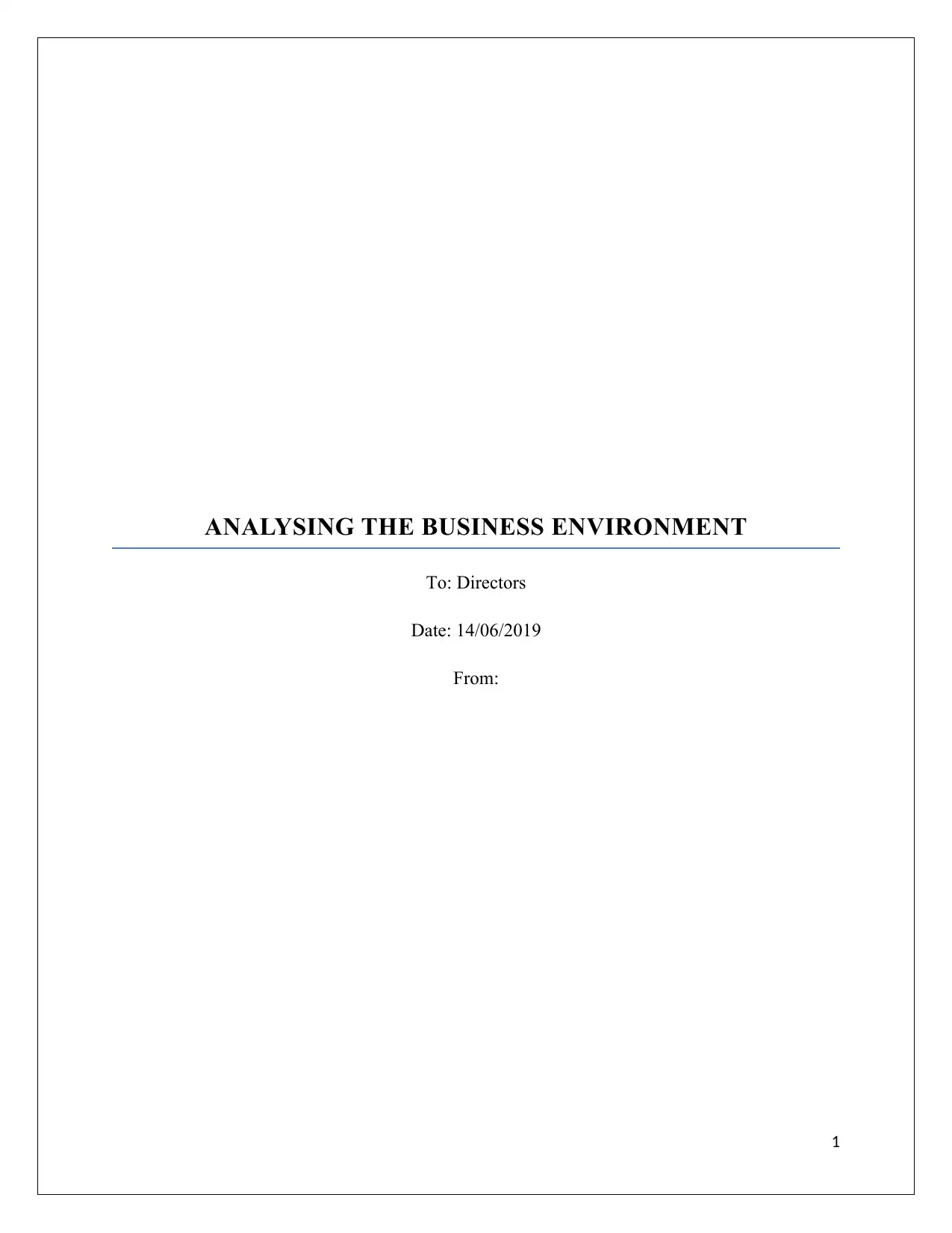
ANALYSING THE BUSINESS ENVIRONMENT
To: Directors
Date: 14/06/2019
From:
1
To: Directors
Date: 14/06/2019
From:
1
Paraphrase This Document
Need a fresh take? Get an instant paraphrase of this document with our AI Paraphraser
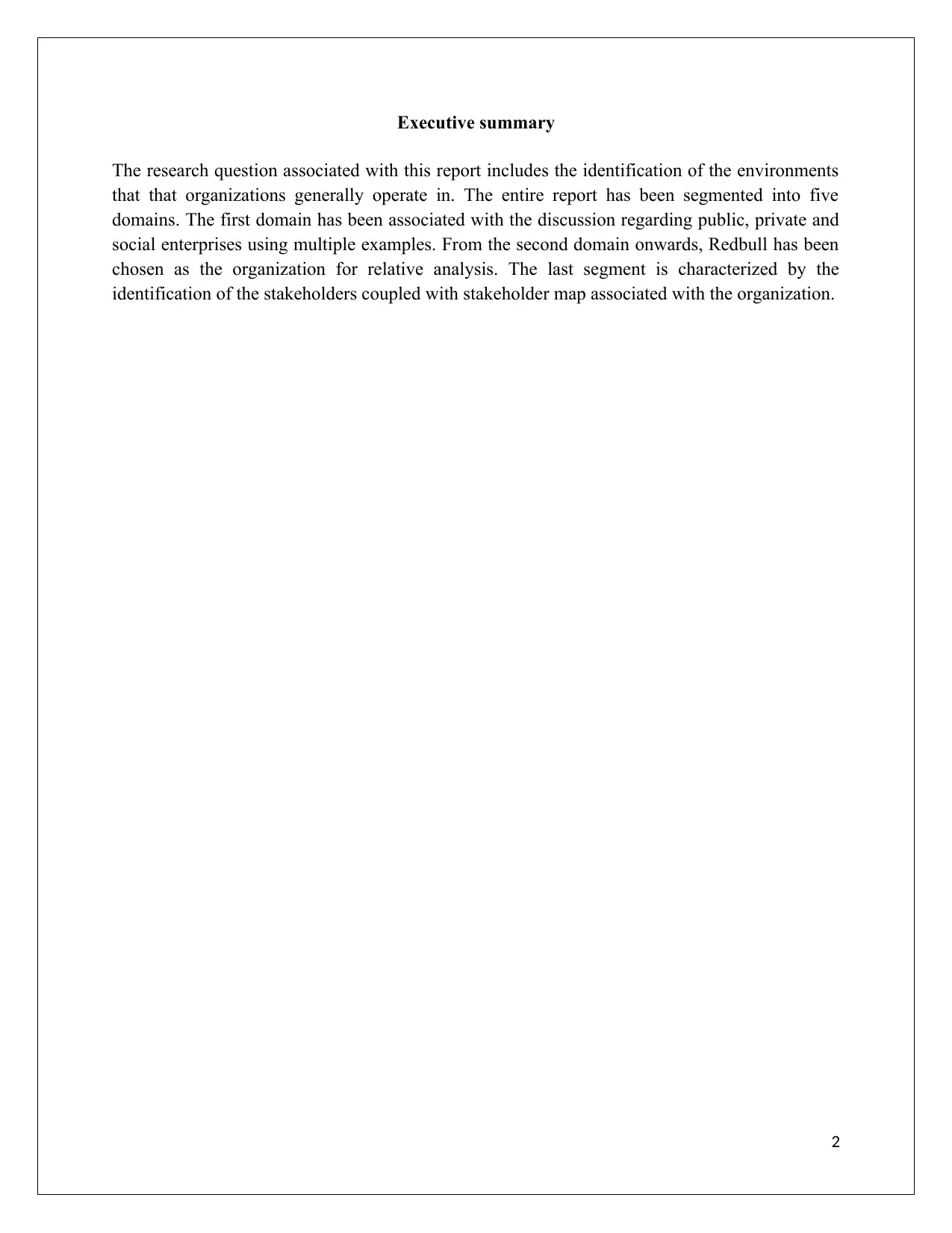
Executive summary
The research question associated with this report includes the identification of the environments
that that organizations generally operate in. The entire report has been segmented into five
domains. The first domain has been associated with the discussion regarding public, private and
social enterprises using multiple examples. From the second domain onwards, Redbull has been
chosen as the organization for relative analysis. The last segment is characterized by the
identification of the stakeholders coupled with stakeholder map associated with the organization.
2
The research question associated with this report includes the identification of the environments
that that organizations generally operate in. The entire report has been segmented into five
domains. The first domain has been associated with the discussion regarding public, private and
social enterprises using multiple examples. From the second domain onwards, Redbull has been
chosen as the organization for relative analysis. The last segment is characterized by the
identification of the stakeholders coupled with stakeholder map associated with the organization.
2
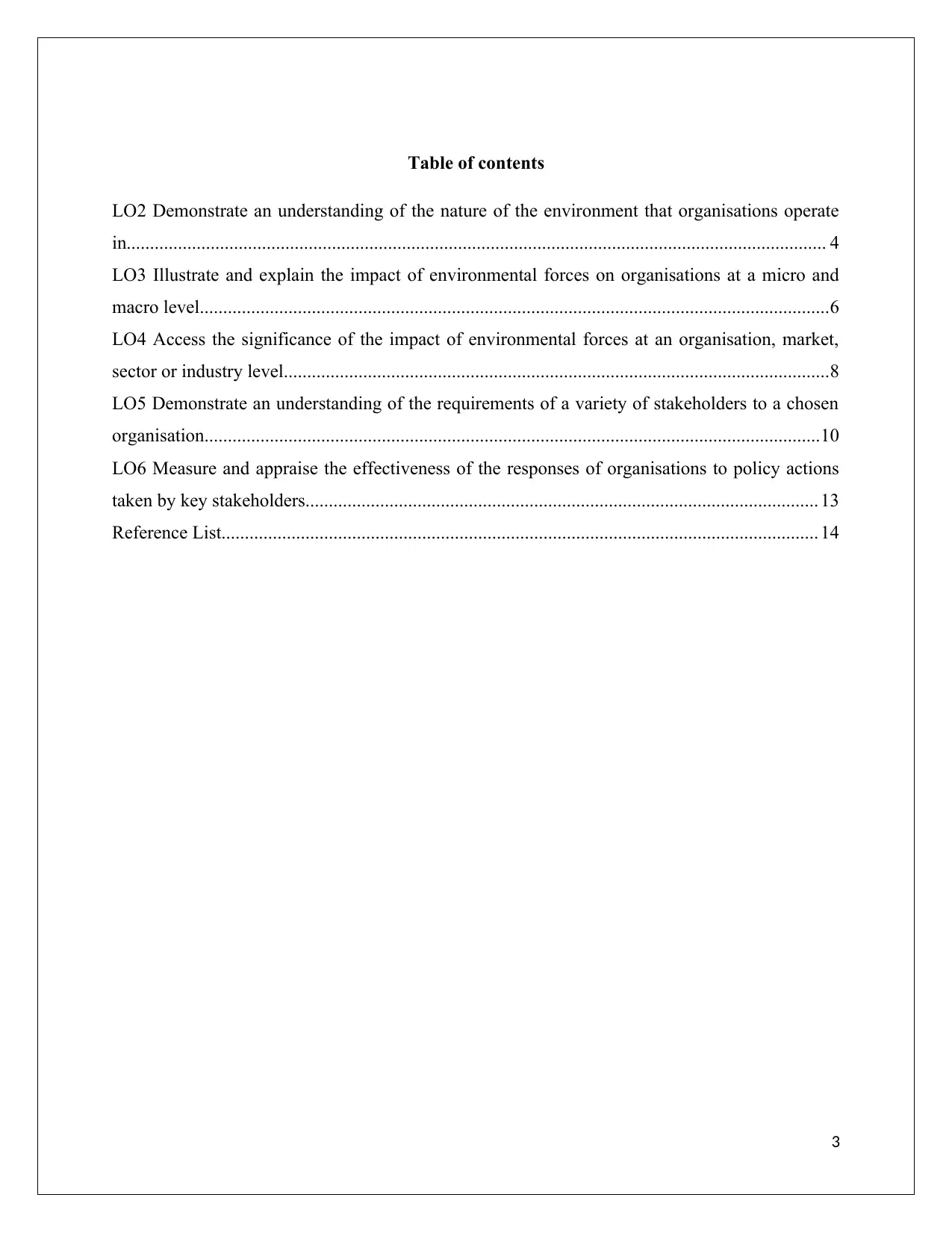
Table of contents
LO2 Demonstrate an understanding of the nature of the environment that organisations operate
in...................................................................................................................................................... 4
LO3 Illustrate and explain the impact of environmental forces on organisations at a micro and
macro level.......................................................................................................................................6
LO4 Access the significance of the impact of environmental forces at an organisation, market,
sector or industry level.....................................................................................................................8
LO5 Demonstrate an understanding of the requirements of a variety of stakeholders to a chosen
organisation....................................................................................................................................10
LO6 Measure and appraise the effectiveness of the responses of organisations to policy actions
taken by key stakeholders.............................................................................................................. 13
Reference List................................................................................................................................ 14
3
LO2 Demonstrate an understanding of the nature of the environment that organisations operate
in...................................................................................................................................................... 4
LO3 Illustrate and explain the impact of environmental forces on organisations at a micro and
macro level.......................................................................................................................................6
LO4 Access the significance of the impact of environmental forces at an organisation, market,
sector or industry level.....................................................................................................................8
LO5 Demonstrate an understanding of the requirements of a variety of stakeholders to a chosen
organisation....................................................................................................................................10
LO6 Measure and appraise the effectiveness of the responses of organisations to policy actions
taken by key stakeholders.............................................................................................................. 13
Reference List................................................................................................................................ 14
3
⊘ This is a preview!⊘
Do you want full access?
Subscribe today to unlock all pages.

Trusted by 1+ million students worldwide
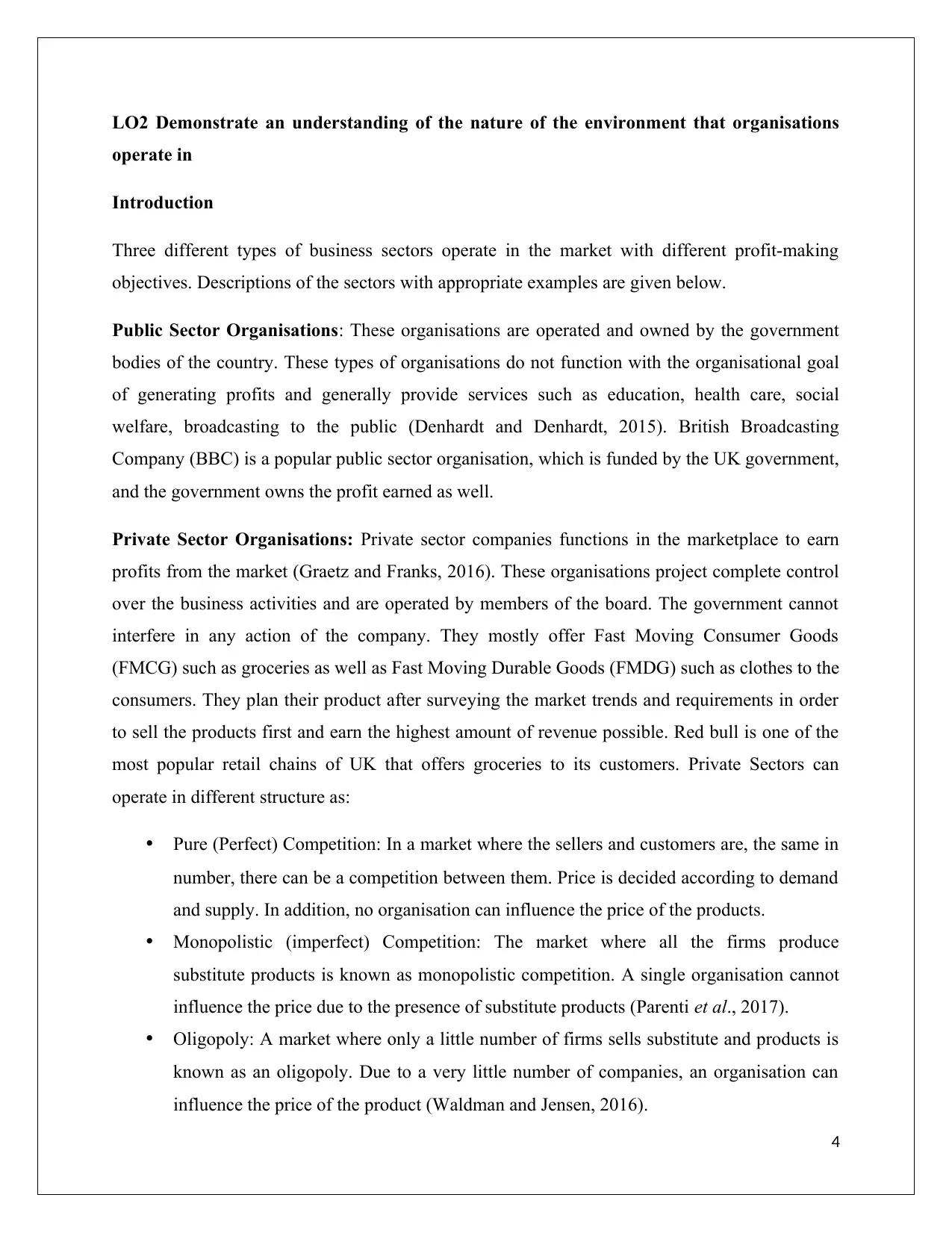
LO2 Demonstrate an understanding of the nature of the environment that organisations
operate in
Introduction
Three different types of business sectors operate in the market with different profit-making
objectives. Descriptions of the sectors with appropriate examples are given below.
Public Sector Organisations: These organisations are operated and owned by the government
bodies of the country. These types of organisations do not function with the organisational goal
of generating profits and generally provide services such as education, health care, social
welfare, broadcasting to the public (Denhardt and Denhardt, 2015). British Broadcasting
Company (BBC) is a popular public sector organisation, which is funded by the UK government,
and the government owns the profit earned as well.
Private Sector Organisations: Private sector companies functions in the marketplace to earn
profits from the market (Graetz and Franks, 2016). These organisations project complete control
over the business activities and are operated by members of the board. The government cannot
interfere in any action of the company. They mostly offer Fast Moving Consumer Goods
(FMCG) such as groceries as well as Fast Moving Durable Goods (FMDG) such as clothes to the
consumers. They plan their product after surveying the market trends and requirements in order
to sell the products first and earn the highest amount of revenue possible. Red bull is one of the
most popular retail chains of UK that offers groceries to its customers. Private Sectors can
operate in different structure as:
Pure (Perfect) Competition: In a market where the sellers and customers are, the same in
number, there can be a competition between them. Price is decided according to demand
and supply. In addition, no organisation can influence the price of the products.
Monopolistic (imperfect) Competition: The market where all the firms produce
substitute products is known as monopolistic competition. A single organisation cannot
influence the price due to the presence of substitute products (Parenti et al., 2017).
Oligopoly: A market where only a little number of firms sells substitute and products is
known as an oligopoly. Due to a very little number of companies, an organisation can
influence the price of the product (Waldman and Jensen, 2016).
4
operate in
Introduction
Three different types of business sectors operate in the market with different profit-making
objectives. Descriptions of the sectors with appropriate examples are given below.
Public Sector Organisations: These organisations are operated and owned by the government
bodies of the country. These types of organisations do not function with the organisational goal
of generating profits and generally provide services such as education, health care, social
welfare, broadcasting to the public (Denhardt and Denhardt, 2015). British Broadcasting
Company (BBC) is a popular public sector organisation, which is funded by the UK government,
and the government owns the profit earned as well.
Private Sector Organisations: Private sector companies functions in the marketplace to earn
profits from the market (Graetz and Franks, 2016). These organisations project complete control
over the business activities and are operated by members of the board. The government cannot
interfere in any action of the company. They mostly offer Fast Moving Consumer Goods
(FMCG) such as groceries as well as Fast Moving Durable Goods (FMDG) such as clothes to the
consumers. They plan their product after surveying the market trends and requirements in order
to sell the products first and earn the highest amount of revenue possible. Red bull is one of the
most popular retail chains of UK that offers groceries to its customers. Private Sectors can
operate in different structure as:
Pure (Perfect) Competition: In a market where the sellers and customers are, the same in
number, there can be a competition between them. Price is decided according to demand
and supply. In addition, no organisation can influence the price of the products.
Monopolistic (imperfect) Competition: The market where all the firms produce
substitute products is known as monopolistic competition. A single organisation cannot
influence the price due to the presence of substitute products (Parenti et al., 2017).
Oligopoly: A market where only a little number of firms sells substitute and products is
known as an oligopoly. Due to a very little number of companies, an organisation can
influence the price of the product (Waldman and Jensen, 2016).
4
Paraphrase This Document
Need a fresh take? Get an instant paraphrase of this document with our AI Paraphraser
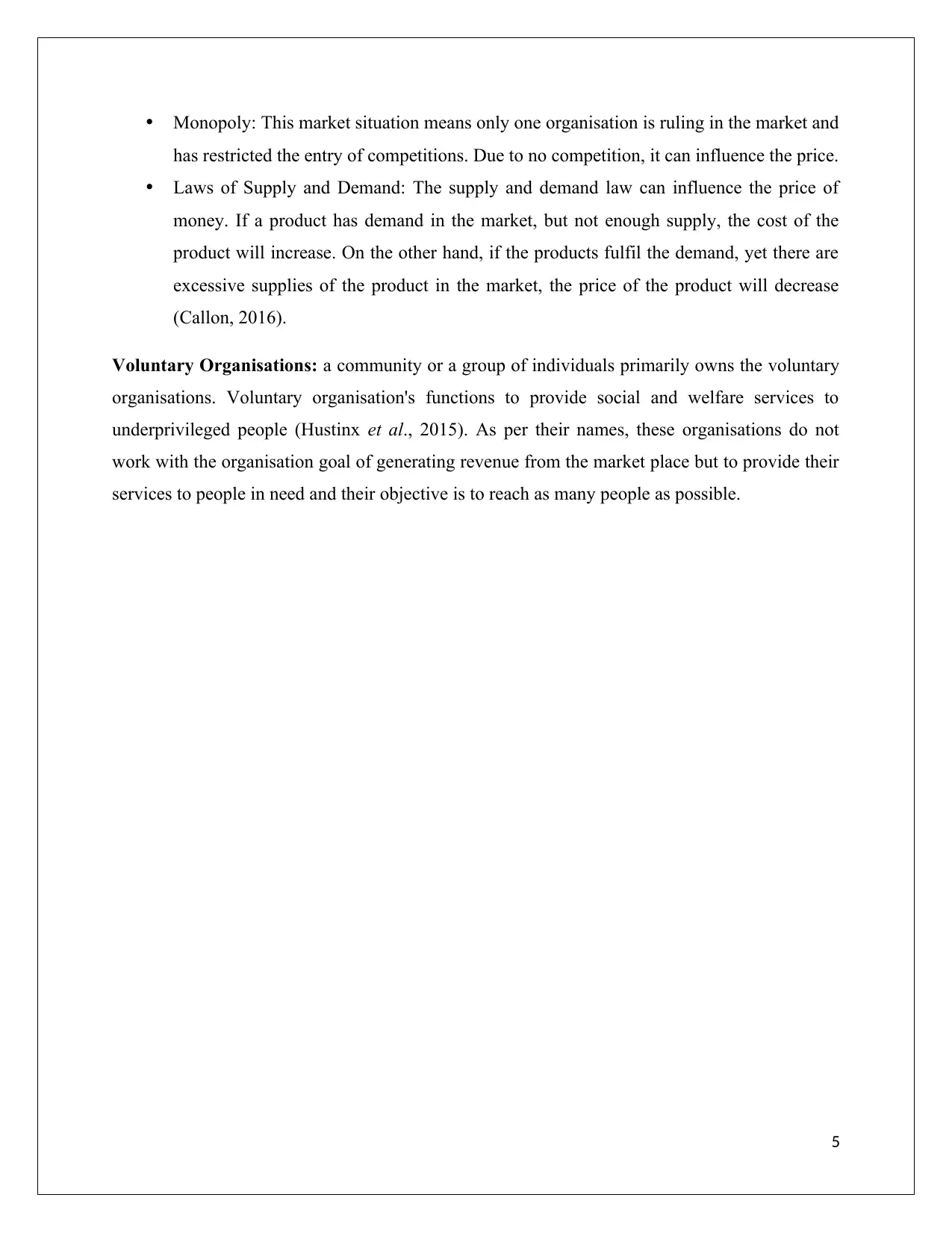
Monopoly: This market situation means only one organisation is ruling in the market and
has restricted the entry of competitions. Due to no competition, it can influence the price.
Laws of Supply and Demand: The supply and demand law can influence the price of
money. If a product has demand in the market, but not enough supply, the cost of the
product will increase. On the other hand, if the products fulfil the demand, yet there are
excessive supplies of the product in the market, the price of the product will decrease
(Callon, 2016).
Voluntary Organisations: a community or a group of individuals primarily owns the voluntary
organisations. Voluntary organisation's functions to provide social and welfare services to
underprivileged people (Hustinx et al., 2015). As per their names, these organisations do not
work with the organisation goal of generating revenue from the market place but to provide their
services to people in need and their objective is to reach as many people as possible.
5
has restricted the entry of competitions. Due to no competition, it can influence the price.
Laws of Supply and Demand: The supply and demand law can influence the price of
money. If a product has demand in the market, but not enough supply, the cost of the
product will increase. On the other hand, if the products fulfil the demand, yet there are
excessive supplies of the product in the market, the price of the product will decrease
(Callon, 2016).
Voluntary Organisations: a community or a group of individuals primarily owns the voluntary
organisations. Voluntary organisation's functions to provide social and welfare services to
underprivileged people (Hustinx et al., 2015). As per their names, these organisations do not
work with the organisation goal of generating revenue from the market place but to provide their
services to people in need and their objective is to reach as many people as possible.
5
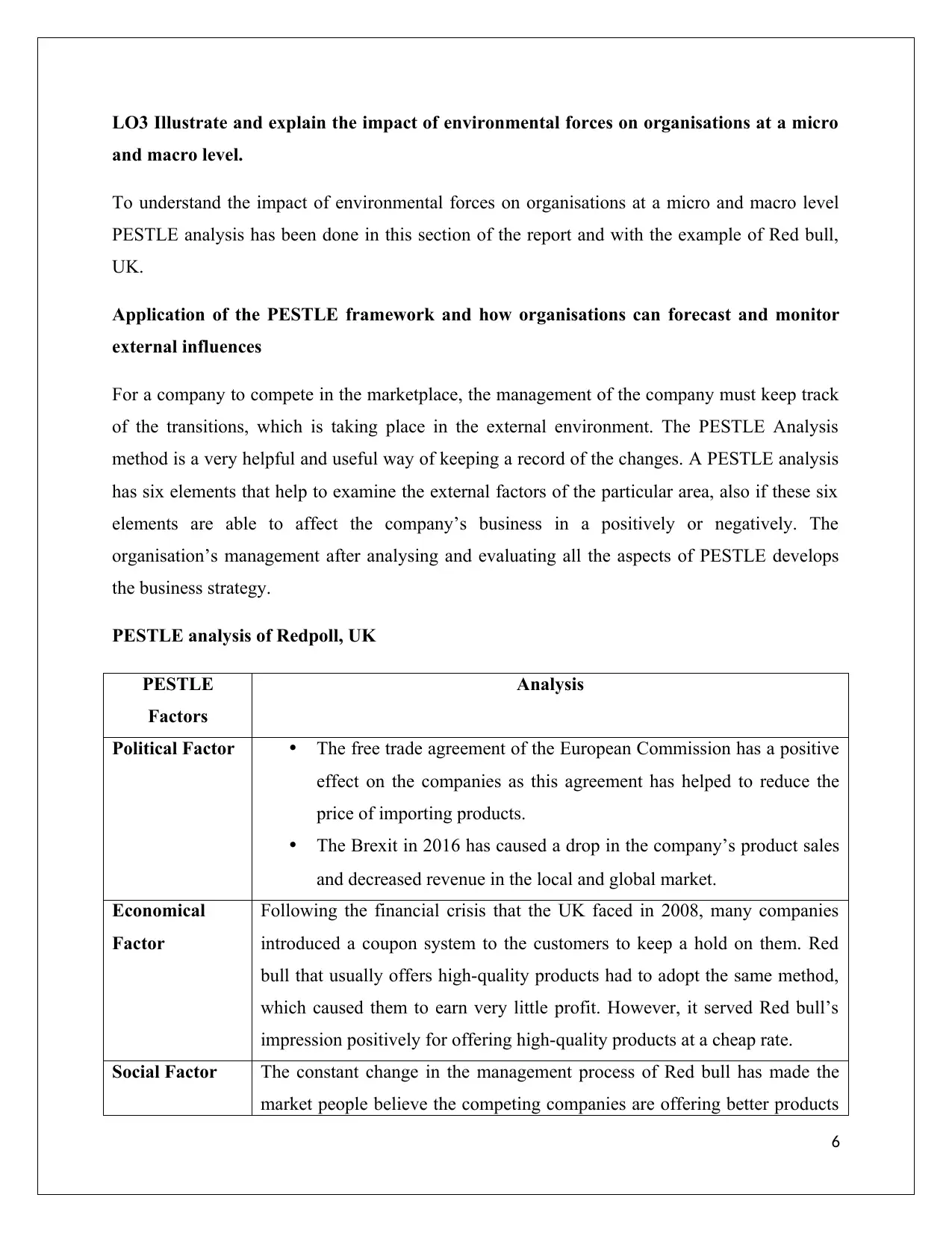
LO3 Illustrate and explain the impact of environmental forces on organisations at a micro
and macro level.
To understand the impact of environmental forces on organisations at a micro and macro level
PESTLE analysis has been done in this section of the report and with the example of Red bull,
UK.
Application of the PESTLE framework and how organisations can forecast and monitor
external influences
For a company to compete in the marketplace, the management of the company must keep track
of the transitions, which is taking place in the external environment. The PESTLE Analysis
method is a very helpful and useful way of keeping a record of the changes. A PESTLE analysis
has six elements that help to examine the external factors of the particular area, also if these six
elements are able to affect the company’s business in a positively or negatively. The
organisation’s management after analysing and evaluating all the aspects of PESTLE develops
the business strategy.
PESTLE analysis of Redpoll, UK
PESTLE
Factors
Analysis
Political Factor The free trade agreement of the European Commission has a positive
effect on the companies as this agreement has helped to reduce the
price of importing products.
The Brexit in 2016 has caused a drop in the company’s product sales
and decreased revenue in the local and global market.
Economical
Factor
Following the financial crisis that the UK faced in 2008, many companies
introduced a coupon system to the customers to keep a hold on them. Red
bull that usually offers high-quality products had to adopt the same method,
which caused them to earn very little profit. However, it served Red bull’s
impression positively for offering high-quality products at a cheap rate.
Social Factor The constant change in the management process of Red bull has made the
market people believe the competing companies are offering better products
6
and macro level.
To understand the impact of environmental forces on organisations at a micro and macro level
PESTLE analysis has been done in this section of the report and with the example of Red bull,
UK.
Application of the PESTLE framework and how organisations can forecast and monitor
external influences
For a company to compete in the marketplace, the management of the company must keep track
of the transitions, which is taking place in the external environment. The PESTLE Analysis
method is a very helpful and useful way of keeping a record of the changes. A PESTLE analysis
has six elements that help to examine the external factors of the particular area, also if these six
elements are able to affect the company’s business in a positively or negatively. The
organisation’s management after analysing and evaluating all the aspects of PESTLE develops
the business strategy.
PESTLE analysis of Redpoll, UK
PESTLE
Factors
Analysis
Political Factor The free trade agreement of the European Commission has a positive
effect on the companies as this agreement has helped to reduce the
price of importing products.
The Brexit in 2016 has caused a drop in the company’s product sales
and decreased revenue in the local and global market.
Economical
Factor
Following the financial crisis that the UK faced in 2008, many companies
introduced a coupon system to the customers to keep a hold on them. Red
bull that usually offers high-quality products had to adopt the same method,
which caused them to earn very little profit. However, it served Red bull’s
impression positively for offering high-quality products at a cheap rate.
Social Factor The constant change in the management process of Red bull has made the
market people believe the competing companies are offering better products
6
⊘ This is a preview!⊘
Do you want full access?
Subscribe today to unlock all pages.

Trusted by 1+ million students worldwide
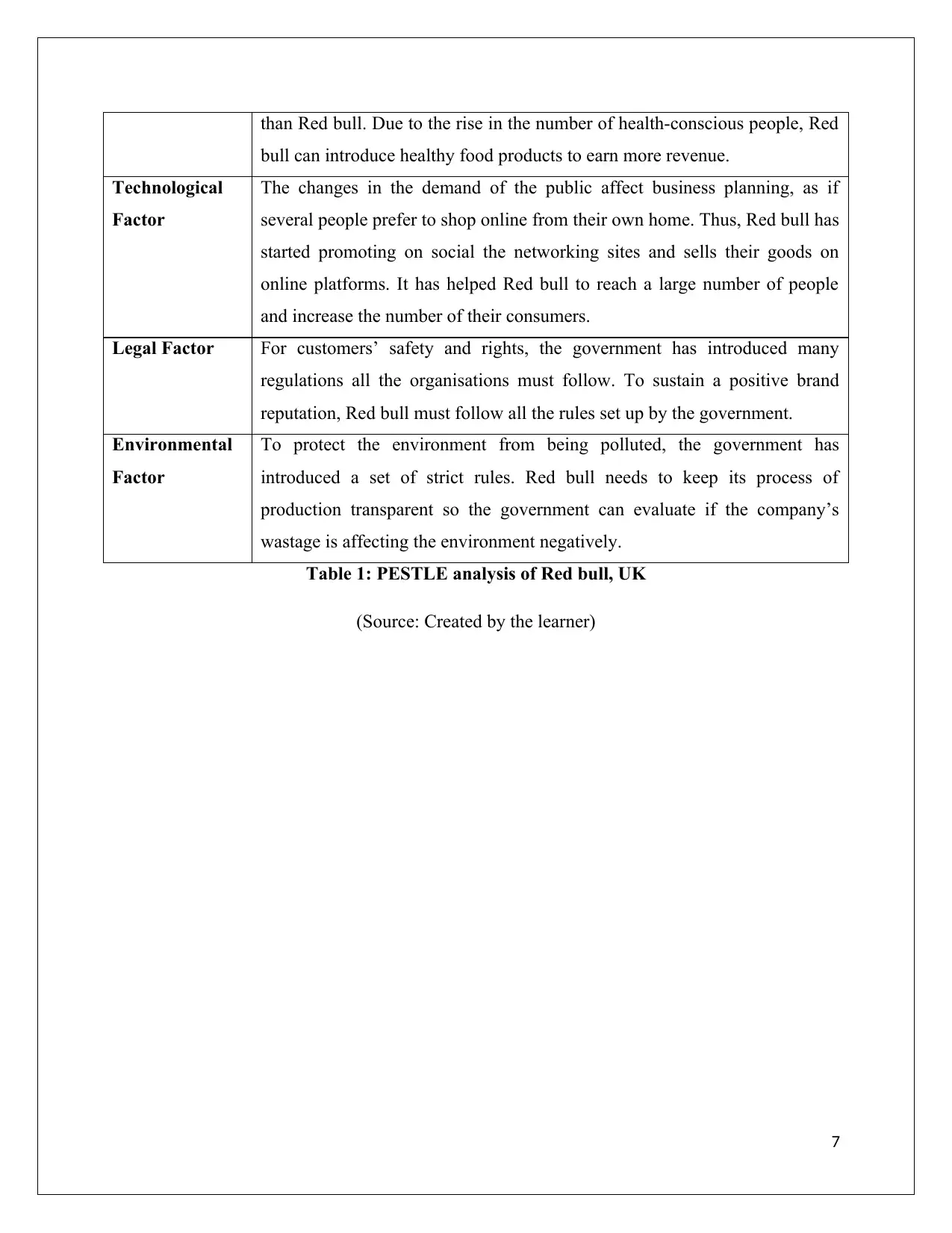
than Red bull. Due to the rise in the number of health-conscious people, Red
bull can introduce healthy food products to earn more revenue.
Technological
Factor
The changes in the demand of the public affect business planning, as if
several people prefer to shop online from their own home. Thus, Red bull has
started promoting on social the networking sites and sells their goods on
online platforms. It has helped Red bull to reach a large number of people
and increase the number of their consumers.
Legal Factor For customers’ safety and rights, the government has introduced many
regulations all the organisations must follow. To sustain a positive brand
reputation, Red bull must follow all the rules set up by the government.
Environmental
Factor
To protect the environment from being polluted, the government has
introduced a set of strict rules. Red bull needs to keep its process of
production transparent so the government can evaluate if the company’s
wastage is affecting the environment negatively.
Table 1: PESTLE analysis of Red bull, UK
(Source: Created by the learner)
7
bull can introduce healthy food products to earn more revenue.
Technological
Factor
The changes in the demand of the public affect business planning, as if
several people prefer to shop online from their own home. Thus, Red bull has
started promoting on social the networking sites and sells their goods on
online platforms. It has helped Red bull to reach a large number of people
and increase the number of their consumers.
Legal Factor For customers’ safety and rights, the government has introduced many
regulations all the organisations must follow. To sustain a positive brand
reputation, Red bull must follow all the rules set up by the government.
Environmental
Factor
To protect the environment from being polluted, the government has
introduced a set of strict rules. Red bull needs to keep its process of
production transparent so the government can evaluate if the company’s
wastage is affecting the environment negatively.
Table 1: PESTLE analysis of Red bull, UK
(Source: Created by the learner)
7
Paraphrase This Document
Need a fresh take? Get an instant paraphrase of this document with our AI Paraphraser
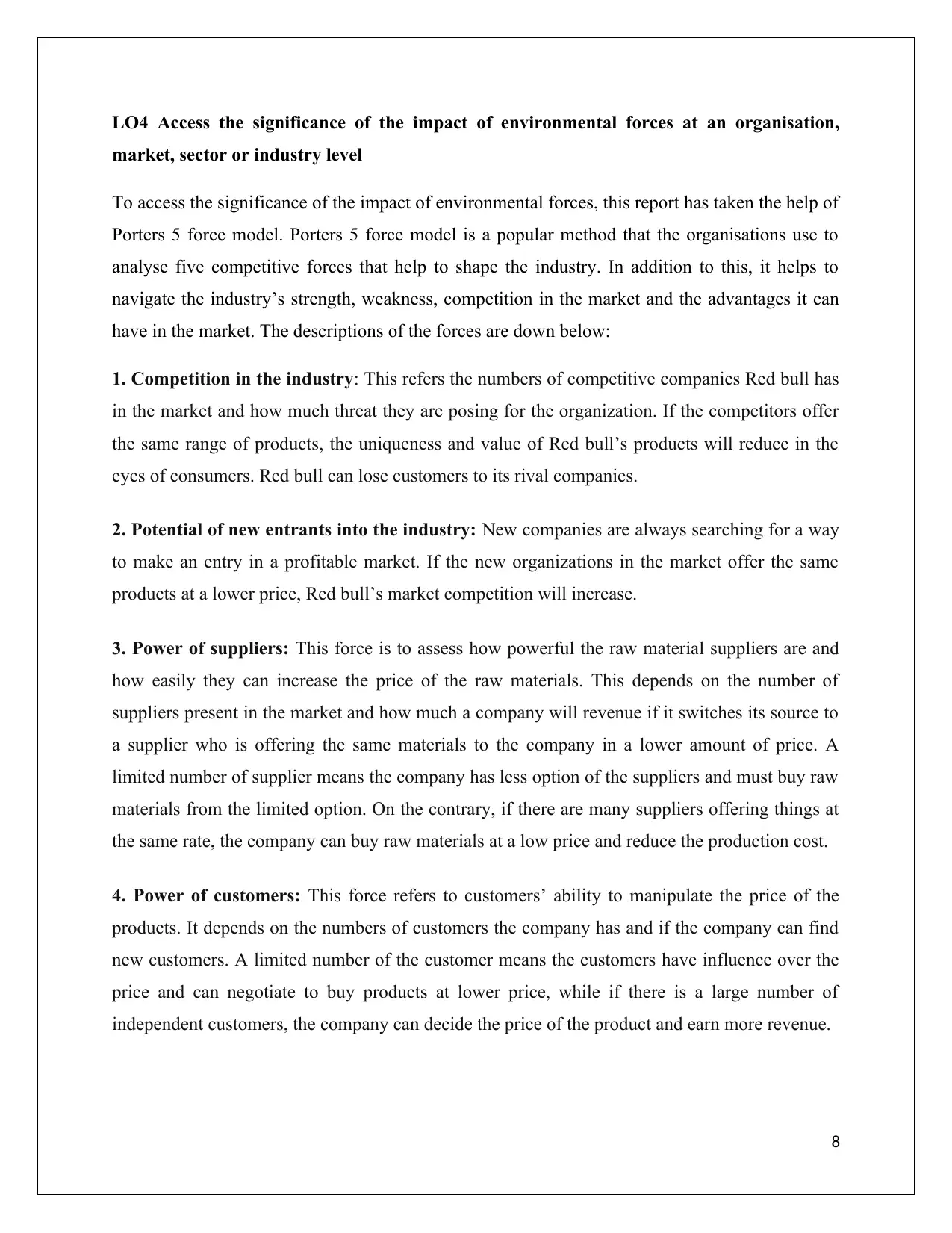
LO4 Access the significance of the impact of environmental forces at an organisation,
market, sector or industry level
To access the significance of the impact of environmental forces, this report has taken the help of
Porters 5 force model. Porters 5 force model is a popular method that the organisations use to
analyse five competitive forces that help to shape the industry. In addition to this, it helps to
navigate the industry’s strength, weakness, competition in the market and the advantages it can
have in the market. The descriptions of the forces are down below:
1. Competition in the industry: This refers the numbers of competitive companies Red bull has
in the market and how much threat they are posing for the organization. If the competitors offer
the same range of products, the uniqueness and value of Red bull’s products will reduce in the
eyes of consumers. Red bull can lose customers to its rival companies.
2. Potential of new entrants into the industry: New companies are always searching for a way
to make an entry in a profitable market. If the new organizations in the market offer the same
products at a lower price, Red bull’s market competition will increase.
3. Power of suppliers: This force is to assess how powerful the raw material suppliers are and
how easily they can increase the price of the raw materials. This depends on the number of
suppliers present in the market and how much a company will revenue if it switches its source to
a supplier who is offering the same materials to the company in a lower amount of price. A
limited number of supplier means the company has less option of the suppliers and must buy raw
materials from the limited option. On the contrary, if there are many suppliers offering things at
the same rate, the company can buy raw materials at a low price and reduce the production cost.
4. Power of customers: This force refers to customers’ ability to manipulate the price of the
products. It depends on the numbers of customers the company has and if the company can find
new customers. A limited number of the customer means the customers have influence over the
price and can negotiate to buy products at lower price, while if there is a large number of
independent customers, the company can decide the price of the product and earn more revenue.
8
market, sector or industry level
To access the significance of the impact of environmental forces, this report has taken the help of
Porters 5 force model. Porters 5 force model is a popular method that the organisations use to
analyse five competitive forces that help to shape the industry. In addition to this, it helps to
navigate the industry’s strength, weakness, competition in the market and the advantages it can
have in the market. The descriptions of the forces are down below:
1. Competition in the industry: This refers the numbers of competitive companies Red bull has
in the market and how much threat they are posing for the organization. If the competitors offer
the same range of products, the uniqueness and value of Red bull’s products will reduce in the
eyes of consumers. Red bull can lose customers to its rival companies.
2. Potential of new entrants into the industry: New companies are always searching for a way
to make an entry in a profitable market. If the new organizations in the market offer the same
products at a lower price, Red bull’s market competition will increase.
3. Power of suppliers: This force is to assess how powerful the raw material suppliers are and
how easily they can increase the price of the raw materials. This depends on the number of
suppliers present in the market and how much a company will revenue if it switches its source to
a supplier who is offering the same materials to the company in a lower amount of price. A
limited number of supplier means the company has less option of the suppliers and must buy raw
materials from the limited option. On the contrary, if there are many suppliers offering things at
the same rate, the company can buy raw materials at a low price and reduce the production cost.
4. Power of customers: This force refers to customers’ ability to manipulate the price of the
products. It depends on the numbers of customers the company has and if the company can find
new customers. A limited number of the customer means the customers have influence over the
price and can negotiate to buy products at lower price, while if there is a large number of
independent customers, the company can decide the price of the product and earn more revenue.
8
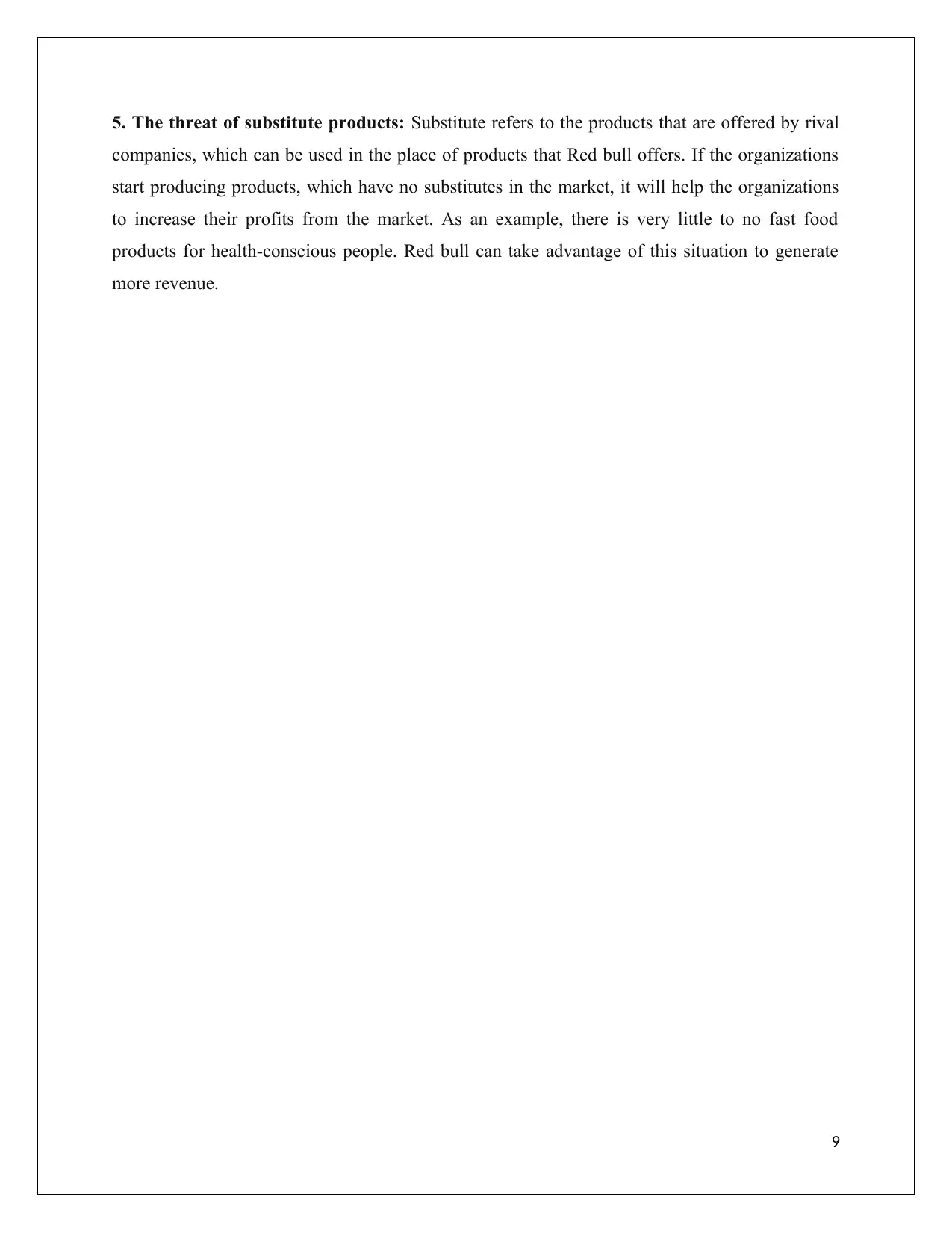
5. The threat of substitute products: Substitute refers to the products that are offered by rival
companies, which can be used in the place of products that Red bull offers. If the organizations
start producing products, which have no substitutes in the market, it will help the organizations
to increase their profits from the market. As an example, there is very little to no fast food
products for health-conscious people. Red bull can take advantage of this situation to generate
more revenue.
9
companies, which can be used in the place of products that Red bull offers. If the organizations
start producing products, which have no substitutes in the market, it will help the organizations
to increase their profits from the market. As an example, there is very little to no fast food
products for health-conscious people. Red bull can take advantage of this situation to generate
more revenue.
9
⊘ This is a preview!⊘
Do you want full access?
Subscribe today to unlock all pages.

Trusted by 1+ million students worldwide
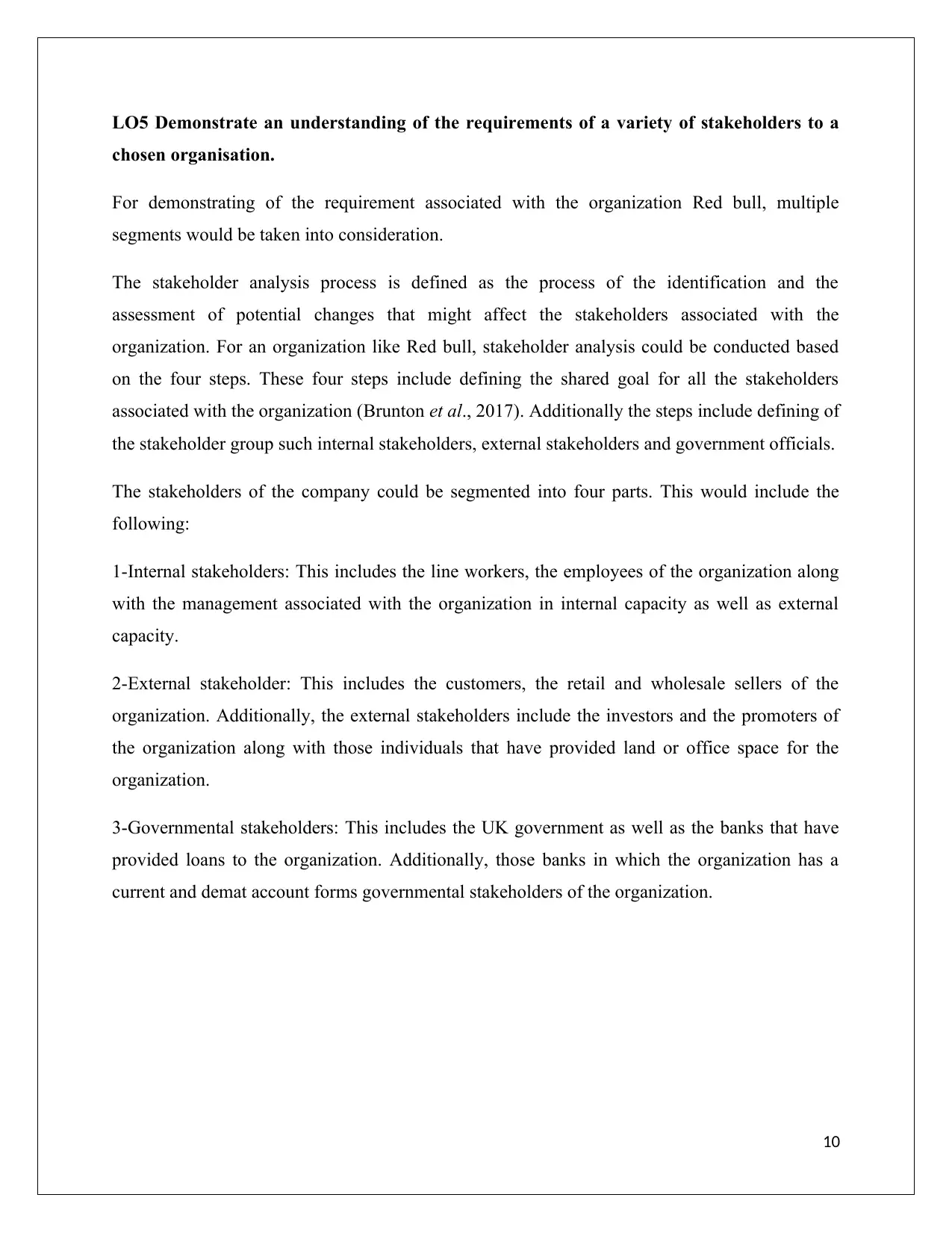
LO5 Demonstrate an understanding of the requirements of a variety of stakeholders to a
chosen organisation.
For demonstrating of the requirement associated with the organization Red bull, multiple
segments would be taken into consideration.
The stakeholder analysis process is defined as the process of the identification and the
assessment of potential changes that might affect the stakeholders associated with the
organization. For an organization like Red bull, stakeholder analysis could be conducted based
on the four steps. These four steps include defining the shared goal for all the stakeholders
associated with the organization (Brunton et al., 2017). Additionally the steps include defining of
the stakeholder group such internal stakeholders, external stakeholders and government officials.
The stakeholders of the company could be segmented into four parts. This would include the
following:
1-Internal stakeholders: This includes the line workers, the employees of the organization along
with the management associated with the organization in internal capacity as well as external
capacity.
2-External stakeholder: This includes the customers, the retail and wholesale sellers of the
organization. Additionally, the external stakeholders include the investors and the promoters of
the organization along with those individuals that have provided land or office space for the
organization.
3-Governmental stakeholders: This includes the UK government as well as the banks that have
provided loans to the organization. Additionally, those banks in which the organization has a
current and demat account forms governmental stakeholders of the organization.
10
chosen organisation.
For demonstrating of the requirement associated with the organization Red bull, multiple
segments would be taken into consideration.
The stakeholder analysis process is defined as the process of the identification and the
assessment of potential changes that might affect the stakeholders associated with the
organization. For an organization like Red bull, stakeholder analysis could be conducted based
on the four steps. These four steps include defining the shared goal for all the stakeholders
associated with the organization (Brunton et al., 2017). Additionally the steps include defining of
the stakeholder group such internal stakeholders, external stakeholders and government officials.
The stakeholders of the company could be segmented into four parts. This would include the
following:
1-Internal stakeholders: This includes the line workers, the employees of the organization along
with the management associated with the organization in internal capacity as well as external
capacity.
2-External stakeholder: This includes the customers, the retail and wholesale sellers of the
organization. Additionally, the external stakeholders include the investors and the promoters of
the organization along with those individuals that have provided land or office space for the
organization.
3-Governmental stakeholders: This includes the UK government as well as the banks that have
provided loans to the organization. Additionally, those banks in which the organization has a
current and demat account forms governmental stakeholders of the organization.
10
Paraphrase This Document
Need a fresh take? Get an instant paraphrase of this document with our AI Paraphraser
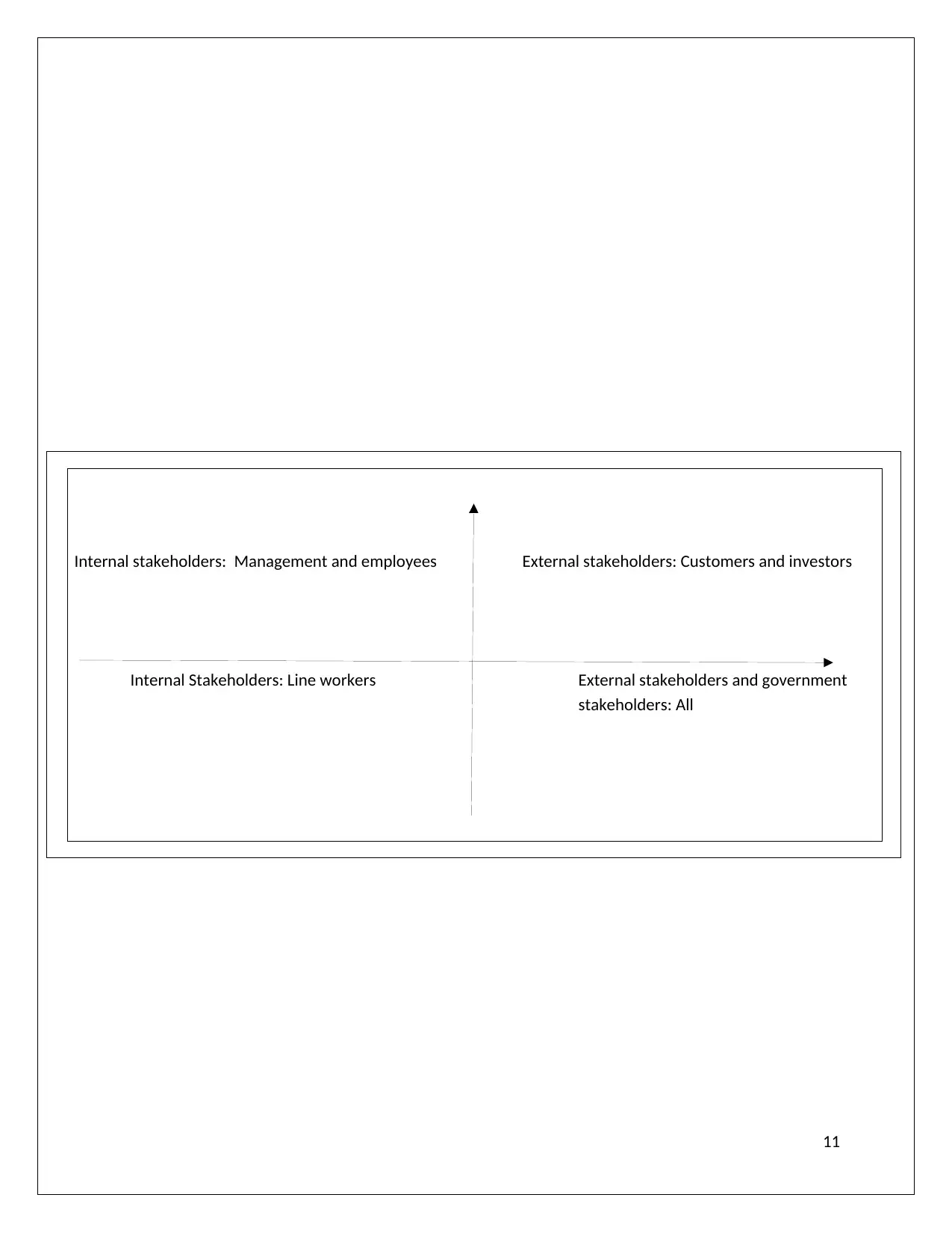
11
Internal stakeholders: Management and employees External stakeholders: Customers and investors
Internal Stakeholders: Line workers External stakeholders and government
stakeholders: All
Internal stakeholders: Management and employees External stakeholders: Customers and investors
Internal Stakeholders: Line workers External stakeholders and government
stakeholders: All
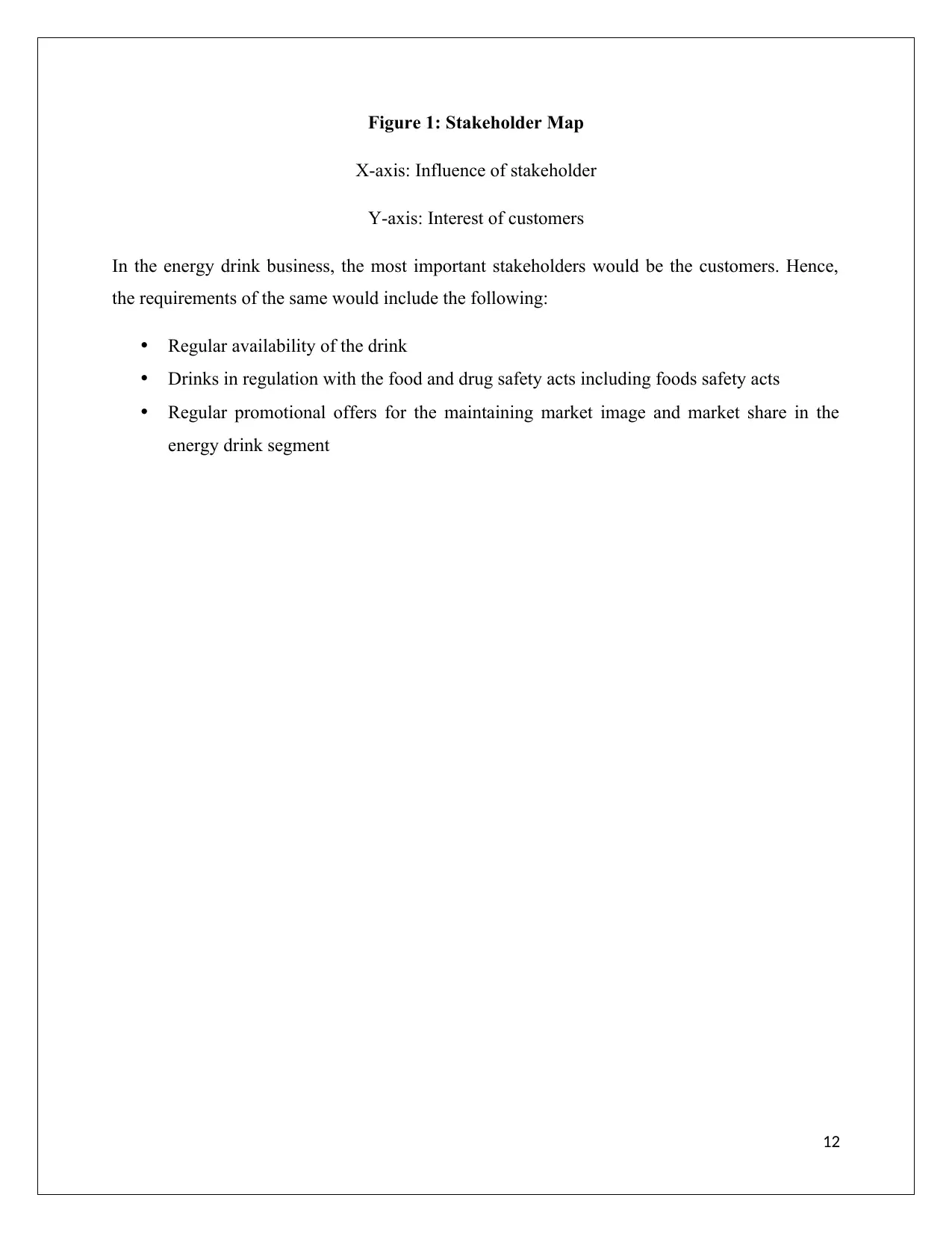
Figure 1: Stakeholder Map
X-axis: Influence of stakeholder
Y-axis: Interest of customers
In the energy drink business, the most important stakeholders would be the customers. Hence,
the requirements of the same would include the following:
Regular availability of the drink
Drinks in regulation with the food and drug safety acts including foods safety acts
Regular promotional offers for the maintaining market image and market share in the
energy drink segment
12
X-axis: Influence of stakeholder
Y-axis: Interest of customers
In the energy drink business, the most important stakeholders would be the customers. Hence,
the requirements of the same would include the following:
Regular availability of the drink
Drinks in regulation with the food and drug safety acts including foods safety acts
Regular promotional offers for the maintaining market image and market share in the
energy drink segment
12
⊘ This is a preview!⊘
Do you want full access?
Subscribe today to unlock all pages.

Trusted by 1+ million students worldwide
1 out of 14
Related Documents
Your All-in-One AI-Powered Toolkit for Academic Success.
+13062052269
info@desklib.com
Available 24*7 on WhatsApp / Email
![[object Object]](/_next/static/media/star-bottom.7253800d.svg)
Unlock your academic potential
Copyright © 2020–2025 A2Z Services. All Rights Reserved. Developed and managed by ZUCOL.


